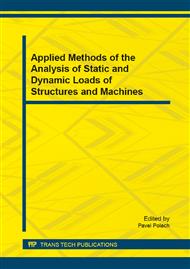p.13
p.20
p.24
p.28
p.32
p.45
p.49
p.55
p.59
Theory of Hole-Drilling Strain-Gage Method for the Using of Semiconductor Strain Gauges
Abstract:
When determining stress states by the hole-drilling method, it is necessary to take into account the experiment performance accuracy. The drilled holes eccentricity appears as a frequent imperfection, which influences essentially the reliability of their stress state assessment. This paper presents the hole-drilling measurement method corresponding to the E 837 standard method, but, at the same time, it is more universal. This method transforms the full stress tensor of the drilled hole position by the regression coefficients and describes the state of strains released in the hole surrounding, based on the hole center distance and its depth. The regress coefficients are not defined in the method concretely for the rosette but they are universal both for the isotropic Hooke’s materials and for the other measuring elements. The method defines the way for the processing of the released strains measured with a defined measuring element and involves naturally the influence of the drilled hole eccentricity and so it is possible, in the hole-drilling method, to apply measuring elements more simply, without determining their specified regression coefficients. Modification of Decomposition theory for semiconductor hole drilling rosette with a greater sensitivity is advantageous.
Info:
Periodical:
Pages:
32-41
Citation:
Online since:
February 2015
Authors:
Price:
Сopyright:
© 2015 Trans Tech Publications Ltd. All Rights Reserved
Share:
Citation:


